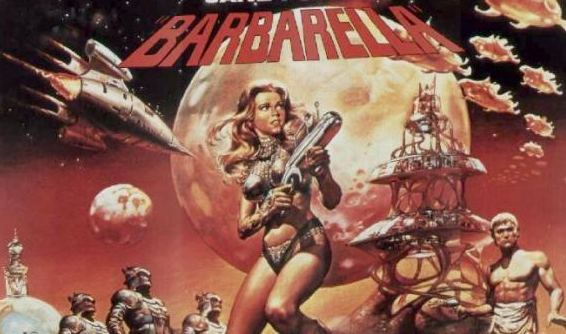Our story opens on Barbarella’s spaceship, the Alpha 7, which is furnished, floor to ceiling, with light brown shag carpeting. How incredibly groovy! Earth tones evidently made a comeback in 40,000 a.d.. The first scene is a unique weightless striptease from a mostly aluminum spacesuit down to the clothes that Jane Fonda (Barbarella) was born wearing. Presumably, Barbarella had just come in from a spacewalk. It becomes evident as the plot progresses that this striptease is as pertinent as anything else in the film.
Digression: One may have to be a certain age to be able to convey what they’re going for here. In 1968, there was the sexual revolution and women’s liberation accompanied by a genuine expectation for world peace in a generation or so. Which means… I am trying frame this. Of course there was love and lust, but we didn’t have to fear it or judge it. We could see and enjoy the feminine form casually without an ulterior agenda. This was sexual liberation – this was the goal anyway. …And that’s why Barbarella doesn’t even think of looking for something to put on when the video phone call from the President of Earth happens. End Digression.
The video phone call comes in from the President of Earth and Rotating Premier of the Sun System, Barbarella stands at attention and salutes. They exchange greetings and then Barbarella offers to put something on, but the President says it’s not necessary because it’s just government work. He has an assignment for her. She has to find Durand-Durand (I’m sure it makes more sense in French and he’s definitely not a rock group). He’s a scientist. Weapons, which are outdated by 40,000 a.d., will be required and so the President borrowed some for her from a museum. So we’re off to extreme deep space, Tau-Ceti 16, which is on the way to Polaris – or something.
A stranger adventure than we could have ever anticipated lies ahead. End of storyline.
Some of my impressions: The music is dated but good. The soundtrack dubbing seems disjointed from the characters at times. The basis is eroticism rather than science fiction. Some of the futuristic ideas do have appeal. Some sets were thoughtfully built with care to detail, but some were not. Things in the sets such as shag carpeting were considered really nice at the time (I remember). The viewer seems to be the only one hoping for a science fiction classic.
There are some explanations; for example the director (and one of seven screenwriters), Roger Vadim, was in love with the lead. One doesn’t really understand the extent of this love until one sees the film. And one tends to forgive the side effects of love most of the time…
In 1968 special effects were often borrowed from the stage, and dialog-driven science fiction was quite acceptable. However, there was a problem, as evidenced by so many writers. Perhaps the transition from comic strip to film is part of the cause. In particular, the scene with the flesh-eating dolls lends itself to a comic strip more readily. The reader of the comic strip can imagine the personalities of the wild children, the dolls, and the rescue; and make it work without effort. In a film, the director has to show all of these factors, make the decisions that imagination automatically makes when reading – and show them. Sometimes it just doesn’t flow.
Regarding casting, the Great Tyrant and Durand Durand were great disappointments to me. On the other hand, I thought Fonda, Hemmings, and Sabato had particularly good energy and caught the spirit of the story.
Science fiction of this period had limited special effects. Sometimes it forced a film whose special effects were unintentionally comical to take a “why try attitude”. This may have happened here. I understand from my research that the original comic strip is much less “’60’s” than the film is. It would be interesting to see a remake that is faithful to the original comic strip and with better special effects; however, Jane Fonda will always be the Barbarella of the ’60’s.

